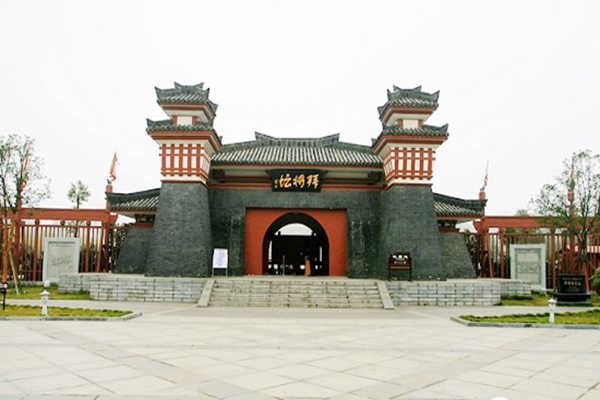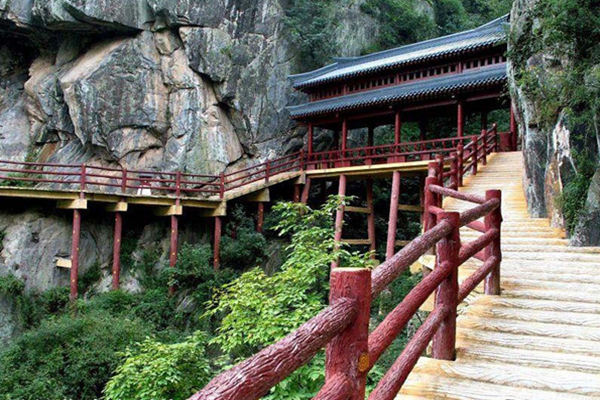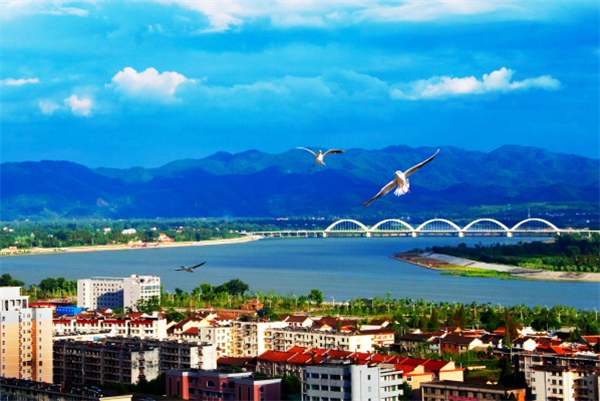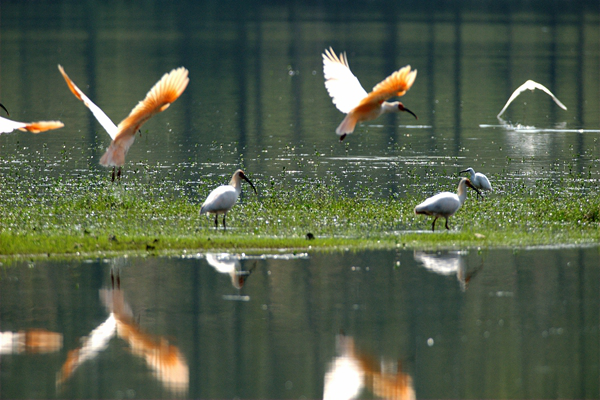- CURRENT LOCATION: HOME
- >> About Shaanxi
- >>
- Cities
Hanzhong
2021-08-27 15:33:00 , Source : The Government Website of Shaanxi ProvinceOfficial Website:http://www.hanzhong.gov.cn/hzszf/English/english.shtml
Hanzhong is the source of the Han River, the first major tributary of the Yangtze River, and the largest city in southern Shaanxi, covering 27,091.9 km² and governing 2 districts and 9 counties. The seventh census data shows that as of November 1, 2020, Hanzhong City has a resident population of 3,211,462. In 2020, Hanzhong City achieved a regional GDP of 159.340 billion yuan.
Hanzhong is known as the hometown of the panda and the "home of the ibis" as it is home to the crested ibis, a kind of the world's endangered bird.
Hanzhong is located at the nowadays head water of the Han River, the largest tributary of the Yangtze River. However some modern historians suggested that the nearby Xihan River, a major tributary of the neighbouring Jialing River to the west, historically drained into the Han River instead, and was later re-routed by a large earthquake at the Wudu Commandery (in modern-day eastern Longnan) in 186 BC, possible due to landslide damming. This might explain the city's name, since its location was historically once the middle point of the ancient Han River.

Hanzhong city covers 27,246 square kilometers (10,520sqmi) and consists of one urban district named Hantai. There are ten surrounding rural counties: (Nanzheng, Chenggu, Mianxian, Yangxian, Xixiang,Ningqiang, Lüeyang, Zhenba, Liuba and Foping) and one national economics and technology development zone. In 2013, the population was approximately 3.84 million. The local dialect of Hanzhong is the Chengdu-Chongqing dialect of Southwestern Mandarin.

The founder of the Han dynasty, Liu Bang, was once enfeoffed as the king of the Hanzhong region after overthrowing the Qin dynasty. During the Chu-Han contention, Liu Bang shortened his title to the King of Han, and later used it as the name of his imperial dynasty. In this way, Hanzhong was responsible for the naming of the Han dynasty, which was later hailed as the first golden age in Chinese history, as well as the principal ethnic group who proudly inherited the name from the dynasty's prominence.
History
Pre-Qin dynasty (before 220 BC)
There are few references to Hanzhong before the Qin dynasty's unification of China in 221 BC. The Book of Documents refers to an area called Liangzhou, while Sima Qian's book Records of the Grand Historian speaks of a "Bao state" ( where the ancient beauty Bao Si came from), both of which are believed to refer to the area now called Hanzhong.
From 900 BC, the area has been called Nanzheng (literally: "southern Zheng"). The ancient geographical treatise entitled Shui Jing Zhu records that Duke Huan of Zheng, a vassal lord from the Western Zhou dynasty, was slain in a battle with the nomadic Quanrong people, and some of the Zheng citizens fled the capital to establish a new settlement to the south, giving rise to the area's name. However, the veracity of this story is controversial.

Qin and Han dynasties (220 BC - 200 AD)
In the Qin dynasty the area was governed as the Hanzhong Commandery, whose seat was in current day Nanzheng County, south of the Hanzhong urban area. In 207 BC, the Qin dynasty collapsed. Liu Bang, who would later become the founding emperor of the Han dynasty, was made lord of Hanzhong. He spent several years there before raising an army to challenge his archrival, Xiang Yu, during the Chu–Han Contention. In 206 BC, after the victory at Gaixia, Liu Bang named his imperial dynasty after his native district, as was customary. However, he chose Hanzhong rather than his birthplace Pei County(present-day Xuzhou,Jiangsu Province).Thus, Hanzhong gave its name to the Han dynasty.

In the second century AD, the Eastern Han dynasty gradually weakened. Outsiders from the Ba region attacked the Hanzhong area, as they had in the past. The Han dynasty lost power. Zhang Lu, supported by followers of a Taoist sect,Way of the Celestial Masters, led an independent theocratic government in Hanzhong.Thirty years later, after the Battle of Yangping, Zhang Lu surrendered Zanghong to the warlord,Cao Cao.
Prior to and during the Three Kingdoms period, Hanzhong was a militarily strategically important site. It is located at a critical point along the route an army would take from the Central Plainto the Sichuan Basin. At this time, Cao Cao lost control of Hanzhong to Liu Bei, who assumed the title of King of Hanzhong. Ruins and landmarks of the Three Kingdoms era remaining in Hanzhong include the tomb of the Shu Han chancellor Zhuge Liang. Much of this period of Hanzhong's history is retold in the historical novel Romance of the Three Kingdoms.
Tang, Song, and Yuan dynasties (618-1368)
In Hanzhong, between the end of the Han dynasty and the beginning of the Tang dynasty there was political turmoil. In 784, when the capital,Chang'an(modern Xi'an) was captured, the Emperor Dezong of Tangfled to Hanzhong. During theNorthern Song dynasty(960 - 1127), however, Hanzhong became economically wealthy with city tax revenue just behind that of regional capitals such as Kaifeng and Chengdu.
Ming and Qing dynasties, and the present (1368-present)
In 1331, during the Ming dynasty in the reign of theHongwu Emperor, extensive renovations were made to Hanzhong's infrastructure. This work brought Zanghong to its present layout and form.
TheWanli Emperor(r. 1572-1620) installed his fifth son, Zhu Changhao (as king of Hanzhong. Changhao built a large, luxurious palace in what is now the Children's Park. The palace's Radiant Glass Wall was demolished during road construction in 1935. Since then, a 13.6 m section has een rebuilt on the eastern end of Sanpu Street.
In 1643, Zhu Changhao fled south to Sichuan ahead of Li Zicheng's rebel army. As he departed, his Hanzhong palace was looted. Qing dynasty historians remembered the massive but empty palace.
In December 1949, in the Chinese Civil War, Hanzhong was captured by the People's Liberation Armyas the Communist Party of China conquered the Kuomintang.

Climate
Hanzhong has a temperate and humid climate. It is classified as humid subtropical(KöppenCwa), with cool, damp winters and hot, humid summers.
The Qin Mountains to the north help shield the city from cold Siberian winds in the winter. Hence, the winter in Hanzhong is warmer than that at similar latitudes east of Shannan. This is despite Hanzhong's elevation and inland location.
In contrast, because of its elevation, Hanzhong summers are temperate, with average highs in July and August about 30°C (86°F). The area is far more humid than central and northern Shaanxi. In Hanzhong, there is 853mm (33.6in) precipitation annually, as compared to 553mm (21.8in) in Xi'an, the provincial capital.The chance of sunshine days per month varies from twenty-six percent in November and December to fifty percent in August. Hanzong receives 1,569 hours of bright sunshine each year. The monthly 24-hour average temperature ranges from 2.4°C (36.3°F) in January to 25.2°C (77.4°F) in July. The annual mean is 14.33°C (57.8°F).

Natural Resources
Thanks to the great nature, Hanzhong is a land with rich resources. Because of its abundant plants, mineral and water resources, it has gained the reputation of “Gene Bank of Natural Species” and “A Treasure Basin in the Mounts Qingling and Bashan”. It is the home of crested ibises, the eastern pearl. The Gaint Pandas, national treasure, enjoy their life in this paradise; The Golden monkeys, takins and a lot of many other rare species also find their homes here. Here also has a rich product of many precious Chinese medicinal herbs, such as tuber of elevated gastrodia, Eucommia Bark, cornel and American ginseng. The reserves of some minerals such as iron, manganese, vanadium, nickel, titanium, gypsum, and asbestos, rank among the first places in China, and Hanzhong is one of the five biggest gold production bases in China. Hanzhong, a land enjoyed splendid water resources, has 567 small and big rivers like the Hanjiang River and the Jialing River with the water reserves of 2.6 million kilowatts. It is one of the places with very rich water resources in the northwest China. So, it is granted to be one of the central water resources areas for “the Water Diversion Project from South to North”. Benefited form its long history and geographical features, Hanzhong is rich in tourist resources. The well-known tourist attractions such as the Changqing Forest Park, the Temple of Marquis Wu, the Scenic Spot of the Nanhu Lake and so on, make Hanzhong an ideal destination for travelling.
With its obvious advantages of its geographic location, Hanzhong is the junction point of Sichuan, Shaanxi and Gansu Provinces, the gateway from the north to the south and one of the key transportation routes in China. Along with the improvement of transportation conditions of highways, railways and airplanes, and the implementation of the developing strategy of “A City with A Population of One Hundred Million & an Area of One Hundred Square Kilometers Project”, Hanzhong will become an important transition hub to connect the north and the south, the east and the west, and an important intersection city in the West Triangle Zone.

Economic Growth
Since China’s implementation of Reform and Opening up policy, especially recent years, the government of Hanzhong has been taking the opportunities from the state strategy of developing China’s western region, it has speeded up its path to adjust economic structure, vigorously practiced the strategy of “To develop green industry, to build a green Hanzhong”. Therefore, a series of key enterprises such as the Hanjiang Machine Tool Company, the Shaanxi Aircraft Manufacture, the Hanzhong Zinc Company, the Hanzhong Steel & Iron Company have been positively developed.

At the same time, Hanzhong has also attached importance to develop an agriculture mainstay industry with high quality of grains and edible oil, live pigs, tea, orange etc. The eco-tourism industry in Hanzhong has been greatly enhanced based on the extensive development of major tourist attractions, such as the four scenic sports (Huayang Changqing Scenic Spot, the Liping Forest Scenic Spot , the Scenic Spot of the Dingjun Mountains feathered with culture of the Three kingdoms period, the Scenic Spot of the Zhangliang Temple and the Zibo Mountains) and four lakes (the Nanhu Lake, the Xingyuan Lake, the Nansha Lake and the Hongsi Lake), and four gardens (the Cherry Garden in Xixiang County, the Tea garden, the Orange Garden in Chenggu County and the Pear Garden in Yangxian County. Modern logistics service industry has also been raised here. Therefore, Hanzhong has preliminarily established a system concerning four main industries, including the equipment manufacture, copper metallurgy, the green industry and the eco-tourism. It is listed by the state as one of the Accumulation areas of circular economical industry. The whole economy and society of Hanzhong City develops fast and tremendous changes appear with each new day. With stable and harmonious social environment, the people here enjoy a happy and comfortable life.
Hanzhong, an opening city, a developing and dynamic city, is striving in its full swing to compose a new chapter of prosperity.

Government Organizations



Other Links

Copyright@www.shaanxi.gov.cn All Rights Reserved
Registration Number:陕ICP备10004160号
